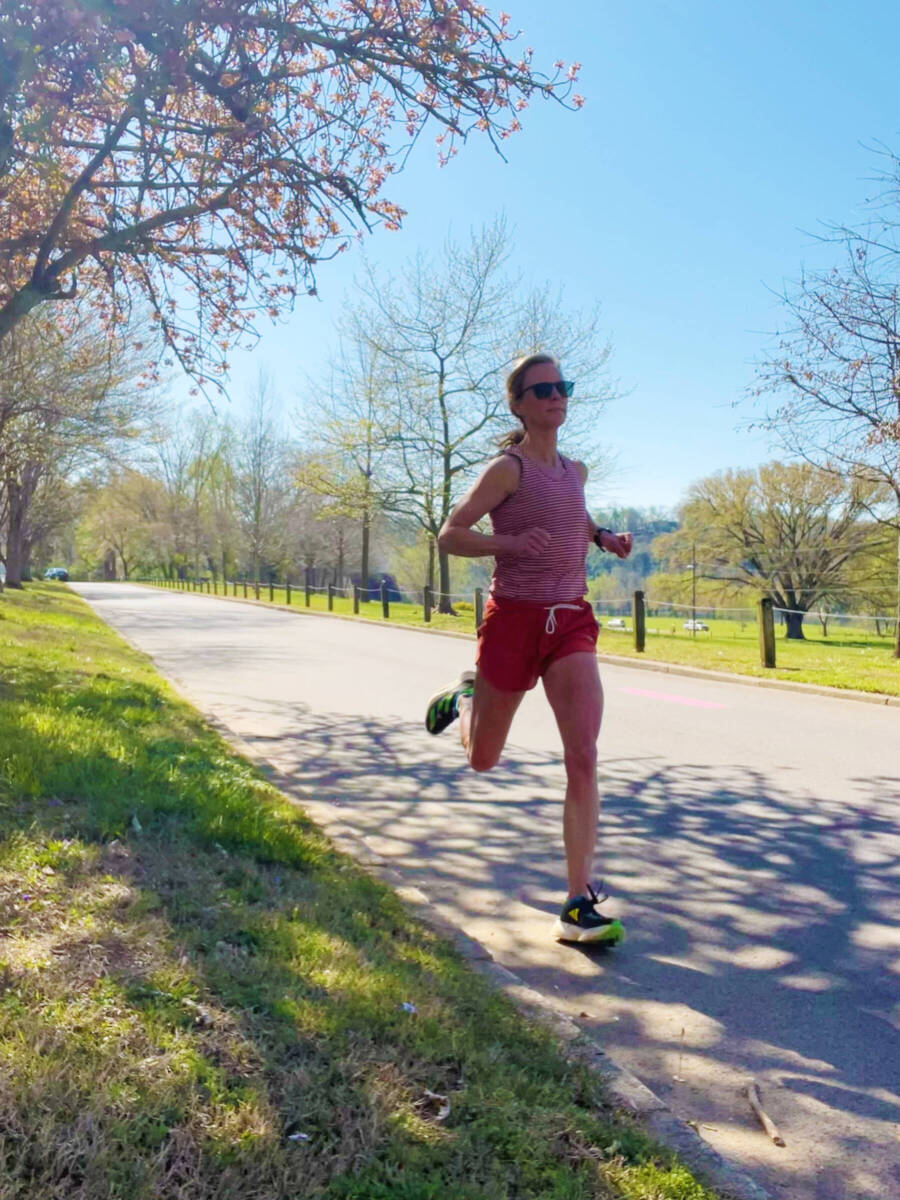Strides work wonders in improving neuromuscular fitness, running form, running economy, and strengthening your body. Research shows that running strides (also called accelerations, striders or stride-outs) a couple of times a week can improve running performance more than most “extra” things you do other than straight running. Strides are not sprints. They are accelerations of speed over the distance of about 100 meters. Read on to learn how and when to do them.

When I’ve come back from long layoffs due to running injuries, strides have worked wonders in helping my body remember how to run efficiently. I can literally feel my body mechanics improve. When I came back from a hamstring tear, I could feel my right leg exploring how to pick up as fast as my left (uninjured) leg. I can feel the power even out. My athletes feel this too when we start incorporating strides into their running.
However, you can do strides wrong so that you don’t get benefits and even get injured. I want to help you avoid that.

Table of contents
- What are strides in running?
- How do you do running strides?
- When should you run strides?
- What are mistakes to avoid in running strides?
- Should I run strides before a race?
- What pace should strides be run at?
- How many strides should you do?
- Why should I run strides?
- Can I run strides on a treadmill?
- Can I run strides barefoot?
- What Science Has Found About Running Strides
Buckle up and let’s go!
What are strides in running?
Running strides are a gradual acceleration over short distances such as 20 to 30 seconds or 100 meters. (They are also sometimes called striders or stride-outs).
With your strides, you gradually accelerate your pace so that you are running close to top speed in the middle (for less than ten seconds), and then decelerate to a jog at the end. Think of strides as a bell curve where you are at the height of your speed only in the center.
Strides are not the same as sprints which are full-out running at maximum speed for the duration of the distance.
Strides are also not the same as intervals. Intervals are meant to increase heart rate and improve cardiovascular fitness. For intervals, you run for longer and have a shorter recovery time. For strides, you run for short distances, have a full recovery before your next stride, and focus on good form over a fast pace.
Related: How to Fix Running Form
How do you do running strides?
You run strides on any flat straightaway path. Here’s how to do running strides:
- Find a flat, straight surface about a football field’s length or 100 meters. If you don’t measure your strides, you can aim to run strides for about 25 seconds.
- Begin to pick up speed so that you are running at 95 percent of your top speed at about 40-50 meters in.
- Hold your top speed for about 5 seconds.
- Decelerate to a jog.
- Focus on standing tall, with your arms swinging by your sides, legs under your body, hips straight, and a quick turnover on your feet. You may even run on your toes to pick up speed.
- Stop, wait a full minute, or until fully recovered.
- Then, repeat (usually 4-6 times at the end of a run or before a workout).
It’s important to remember that the purpose of strides is not to strengthen your cardiovascular system. The purpose of strides in running is to improve your neuromuscular system. So proper form is paramount.
Thus, shortening the recovery time in which you are running strides while still fatigued provides zero benefits.
Related: How Many Miles Should I Run in a Day?

When should you run strides?
Aim to run strides after an easy run a couple of times a week. Here’s how to introduce running strides into your running training schedule:
- After you’ve been running consistently for 3 days or more a week for at least 6 weeks, you can introduce running strides into your running.
- Start strides two days a week after the end of an easy run, on nonconsecutive days.
- Complete your easy run.
- Find a straight, flat surface to run your strides.
- Start with 4 strides.
- Remember to focus on form and fully recover in between.
- After a couple of weeks of strides, you can add one and do 5, then 6.
- As your training progress, you can run strides after a warm-up before a speed workout, tempo run, or on race day prior to lining up.
- You can also try hill strides one day per week, starting with 4, in which you run about 50 meters at a progressively faster pace on a gradual incline.
Related: Free Training Plans!
What are mistakes to avoid in running strides?
If you are incorporating strides in your running, do not do the below.
Do not:
- run strides downhill
- rush your recovery time
- sprint the whole way
- come to a sudden stop
- run with poor form
- choose an uneven or crooked path
Should I run strides before a race?
Strides are also used as part of a warm-up before a hard effort or race as they loosen up the tendons, joints, and muscles.
Here’s how to run strides as a warm-up:
- Do your easy warm-up of 1-2 miles, running drills, and then perform 4 strides right before your race or workout.
- Many people do their strides on the start line of a race.
Related: 8 Running Drills to Make You Run Faster
What pace should strides be run at?
There is no correct pace for strides. Instead, it’s based on your rate of perceived effort. Strides should be run at close to max effort, like a 9.5 out of a scale of 1 to 10.
Your pace for strides is closest to your mile pace. So, if you are a 6-minute miler, your stride pace will be 6 minutes, or faster.
Related: How to Start Running
How many strides should you do?

Start with four strides two times a week, at most four. After a couple of weeks, you can add another stride to each session. Typically, you do not do more than six strides per session.
Do not run strides if you are new to running or are recovering from an injury. You should only attempt strides after running consistently for at least six weeks.
Related: 5-Minute Mobility Routine for Runners
Why should I run strides?
Strides are amazing because you get so much for just a little bit of effort (really a total of about 4 minutes a week). (See below research.)
Strides help:
- Improve running form and turnover
- Improve running economy
- Strengthen muscles and prevent injury, and
- Make you faster.
It does this by improving the connection between your brain and muscles so that when your brain tells your muscles to move, your muscles learn how to do it in the most efficient way possible, using the least amount of energy. This improves cadence and runner’s turnover, hip extension, and stride length.
Related: 9 Steps to Return to Running After Injury
Strides also wake up fast-twitch muscles, making them more ready to work when you hit the ground.
Also, the fast-running creates stress on your bones, muscles, tendons, ligaments, and joints. When you recover, these structures build back faster.
Strides also work as a wonderful bridge to faster running by metabolically and structurally readying the body for the intensity of fast running.
Can I run strides on a treadmill?
You can run strides on a treadmill though it is not ideal or recommended. That is because the main purpose of strides is to improve form and your form is altered on a treadmill. Also, you can’t lengthen your stride on a treadmill as you would when running fast on the ground.
When doing strides running on a treadmill its best to perform them more in the form of surges:
- In the last one or half-mile of your run, slow to a jog and then increase your pace quickly on the treadmill so that you are running close to top speed (but not top speed!).
- Run fast at a controlled pace for about 3-5 seconds, then decrease your speed quickly to a jog, then stop.
- Recover for a minute or so.
- Repeat 4 to 6 times.
- Each acceleration should take about 20 to 30 seconds.
Related: Genius Treadmill Tips for Mother Runners
Can I run strides barefoot?
Running strides barefoot is a great way to strengthen your foot muscles, ankles, and calves. But don’t jump into it!
- Do strides for a couple of weeks before attempting one to two strides in a session barefoot on grass, on a flat, straight surface.
- Next week, aim for up to four barefoot strides in a session.
- If you tolerate that well, aim to do one session of barefoot strides a week for benefits!
What Science Has Found About Running Strides
Research shows that short bursts of speed like running strides can dramatically improve your running performance.
Study 1
A 2018 Journal of Strength and Conditioning article found that runners who did three speed sessions per week for two weeks (4 to 7 30-second fast shuttle runs with 4 minutes recovery between each) found that:
- speed increased by 2.8 percent,
- time to exhaustion increased by 159 seconds, and
- a 3k time trial improved by 5.7 percent.
That’s a lot of improvement in just about 12 to 15 minutes of work!
Study 2
A 2014 review article in Sports Medicine found that in 16 different trials of runners doing 30-second intervals (very similar to striders),
- saw an improvement in aerobic capacity by 8 percent!
Study 3
Another study, published in 2018, in the Physiological Reports, had 20 athletes do 5 to 10 30-second sprints with a 3.5 minute recovery in between. They ALSO reduced weekly running volume by 36 percent. The research found that the participants:
- Running economy during a 10k improved by 2.1 percent (hard effort), and
- running economy during intervals at 60 percent of VO2 max improved by 1.7 percent (easy effort).
How? In general, these speed bouts improved running economy by increasing the enzymatic activity of the aerobic system, making runners able to run faster using less energy. Specifically, these studies found or theorize these running economy improvements come from:
- increased markers of aerobic metabolism,
- improvements in the lactate shuttle,
- enhanced neuromuscular capacity,
- improved slow-twitch fiber structural integrity, and
- improved mitochondrial efficiency (due to decreased expression of a muscle protein called UCP3).
Strides are an amazing way to boost fitness and form! If you are consistently running but not running strides yet, do it! You won’t regret it!
If you want guidance with your running goals, check out my run coaching services. Also, be sure to check out my free training plans:

I love this! Thanks for including the research, too. Sounds like I need to run some strides!
Hannah, they are a game-changer! Thanks for reading!!